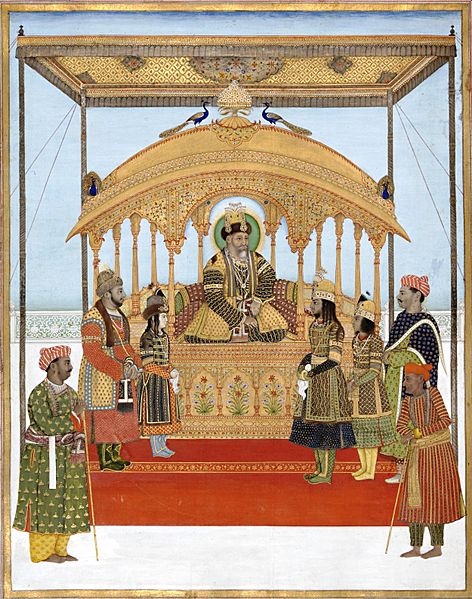Archivo: Ghulam Murtaza Khan The Delhi Darbar of Akbar II

Descripción: The Delhi Darbar of Akbar II. In this painting attributed to the artist Ghulam Murtaza Khan, the Mughal emperor Akbar II (r. 1806-37 CE) holds court from atop an exquisite, jewel-encrusted jharoka, or throne, covered by a baldachin and topped with an embroidered canopy; the jharoka is a copy of the famous Peacock Throne looted by the Iranians under the Afsharid ruler Nadir Shah (r. 1736-47 CE) in 1738-39 CE. Akbar’s sons, Abu Zafar Siraj al-Din (the future Bahadur Shah II and the last ruler of the Mughal dynasty, r. 1838-57 CE), Mirza Salim, Mirza Jahangir and Mirza Babur, stand in attendance on either side of their father. They are visually distinguished from the two barefoot servants flanking the scene by their dress, their situation on the royal red carpet, and their closer proximity to Akbar, whose figure fills the centre of the picture plane.The scene represents a continuation of the Mughal practice of darshan, the presentation ceremony for the Mughals, into the nineteenth century. Darshan reflected a merging of the Hindu practice of that name, meaning “beholding,” with the notion of the king being accessible to his subjects and imparting auspicious blessings to them in the same manner a deity’s image would to its beholder (Asher 1993, p. 282). The Mughal adoption of the darshan ritual from Hindu culture enhanced the rulers’ semi-divine image, alluded to in paintings such as this one by the glowing halo around the ruler’s head. The setting in which Akbar II appears is known as the jharoka-i khass-u-?amm, where the ruler would hold court and take care of administrative duties. The darbar, or assembly, could consist of all classes of people, from family members and court grandees to the general public (hence khass-u-?amm, or “high and low”) (Koch 1997, p. 133). The level of portraiture and detail is exceedingly fine in this painting of a darbar scene. The faces are depicted with subtle shading and highly individualistic features such as the light beards, rounded chins or in the case of the old emissary at right, sunken cheeks. The scene likely takes place in the winter because of the warm clothing, turbans, and headdresses shown. Compare to a larger gathering depicted in E. Smart and D. Walker, Pride of the Princes: Indian Art of the Mughal Era in the Cincinnati Art Museum, 1985, cat. no. 19. and to T. Falk and M. Archer, Indian Miniatures in the India Office Library, 1981, no.227i. E. Smart notes that there are eight similar known darbar pictures, with some also depicting British emissaries. Inscriptions in the other paintings allow the identification of the princes from left to right: Abu Zafar Siraj ud-Din (heir apparent Bahadur Shah II), Mirza Salim, Mirza Jahangir, and Mirza Bahadur. Though not all of the Darbar paintings were by the hand of Ghulam Murtaza Khan, based on the India Office Library painting, one can attribute this painting to him. Though the Mughal Empire was disintegrating, Smart also remarks that the early 19th century was a high point in the production of high quality painting. The artist was successful in capturing the glittering sophistication and decadence of the court, which juxtaposed with the anxious expressions on the principal figures, poignantly evoke the waning Mughal era. Materials and technique: Ink, opaque watercolour and gold on paper Dimensions: 39.4 x 30.9 cm Aga Khan Museum Accession number AKM00214. Auctioned at Christie's in 2001 for US$28,200. Previously property from a New England Collection.
Título: Ghulam Murtaza Khan The Delhi Darbar of Akbar II
Créditos: http://www.akdn.org/museum/detail.asp?artifactid=1647# http://www.christies.com/lotfinder/lot/delhi-darbar-of-akbar-ii-india-delhi-2007164-details.aspx?from=searchresults&intObjectID=2007164&sid=92a69636-e9a4-4525-aaa7-6da01dc80d18
Autor(a): Ghulam Murtaza Khan(?)
Términos de Uso: Dominio Público
Licencia: Dominio Público
¿Se exige la atribución?: No
Usos del archivo
La siguiente página enlaza a este archivo:

